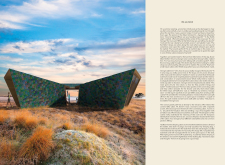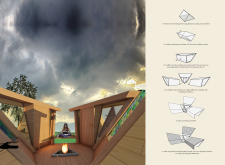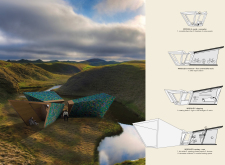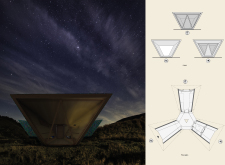5 key facts about this project
Vélo6 is an architectural project designed to cater to long-distance cyclists, providing a multifunctional space that seamlessly integrates with the surrounding landscape. This design serves primarily as a rest and repair station for travelers, emphasizing sustainable practices and community interaction. The architectural layout comprises interconnected modules that fulfill various functions, promoting user engagement while ensuring minimal environmental impact.
Functional Spaces and Layout
The project includes several distinct modules that each serve a specific purpose. Module A is a social area designed for gatherings, featuring movable benches and a communal fireplace, fostering a sense of community among users. Module B serves as the entrance, equipped with secure bike racks and a repair station that addresses the practical needs of cyclists. Module C offers sleeping accommodations with rotating beds and charging stations, allowing travelers to recharge both themselves and their devices. Module D houses eco-friendly sanitary facilities, incorporating elements such as rainwater collection systems and water-efficient fixtures. This functional zoning ensures that each area is dedicated to enhancing the user experience while maintaining a compact footprint.
Material Choices and Sustainability
The material selection is central to the project’s sustainability ethos. Recycled plastic is utilized for the colorful façade, which not only reduces waste but also adds visual interest. The primary structural material is wood, chosen for its thermal properties and aesthetic appeal. Glass is incorporated strategically to enhance daylighting and create a visual connection between the interior and exterior spaces. These choices reflect a commitment to environmental responsibility and practicality, providing both comfort and efficiency.
Innovative Design Approaches
What sets Vélo6 apart from other architectural projects is its focus on community-oriented design and ecological integration. The layout promotes interaction among users, encouraging a communal atmosphere where travelers can share experiences and resources. The design approaches challenge the traditional notion of temporary structures by creating a robust setting that accommodates both immediate needs and longer-term stays. The project also integrates sustainability in its operational aspects, featuring renewable energy sources such as solar panels and water conservation techniques.
The architectural expression and functional design work in concert to create a cohesive experience for users, enhancing both their physical and social needs. The result is a model that not only serves cyclists but also promotes sustainable practices within the broader context of architectural solutions.
For additional insights into the Vélo6 project, including architectural plans, sections, and detailed designs, explore the project presentation. It provides a comprehensive view of the innovative ideas and architectural approaches that define this unique environment.


























